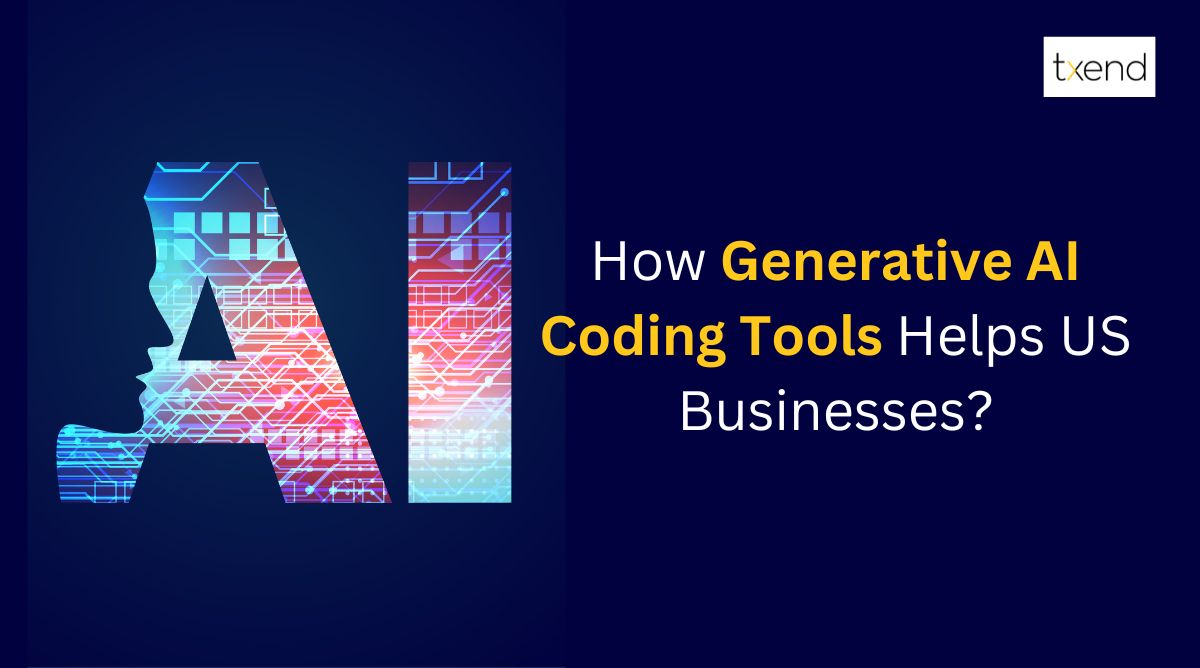What is an AI Code Generator?
An AI code generator is a tool that uses artificial intelligence to generate code automatically. These tools, which automate tedious operations and provide code snippet suggestions, can help engineers create code more quickly and effectively. AI code generators can also generate code for new programming languages or frameworks without requiring the developer to learn them first.
AI code generators work by training on a large dataset of existing code. This training data allows the AI code generator to learn the patterns and conventions of different programming languages and the common tasks that developers need to perform.
Once the AI code generator is trained, it can generate code by providing a natural language description of the desired code.
This article will explore how generative AI coding tools can help US businesses increase productivity and profits. We will go over the advantages of utilizing these technologies as well as some of the issues that must be resolved before they are extensively used.
Key Takeaways
- AI Code Generator is software using AI algorithms to automate or assist in creating code, improving development efficiency and accuracy.
- Benefits of using an AI Code Generator include increased productivity, faster development, reduced errors, and streamlined coding processes.
- Top Generative AI Tools in 2023 for code generation include GitHub Copilot, CodeWhisperer, IBM Watson Code Assistant, Code Llama, and ChatGPT.
- Generative AI in Requirements Analysis streamlines understanding user needs, automates requirement gathering, and aids in accurate requirement documentation.
- Generative AI in Coding expedites coding tasks, improves code quality, and facilitates creative problem-solving, enhancing overall development efficiency.
- Generative AI in Testing automates test case generation, enhances test coverage, and identifies edge cases, ensuring comprehensive and efficient software testing.
- Before adopting generative AI coding tools, challenges include data security, ethical concerns, integration issues, skill upgradation, and cost considerations.
- Solutions involve implementing robust security measures, ethical guidelines, seamless integration, comprehensive training, and conducting cost-benefit analyses for effective adoption.
What are the benefits of using an AI Code Generator?
There are several reasons why businesses in the US should use AI code generators:
Increased productivity:
AI code generators can help developers write code faster and more efficiently by automating repetitive tasks and suggesting code snippets. This can allow up developers to work on more strategic and creative projects.
Improved code quality:
AI code generators can help developers write higher-quality code by suggesting best practices and identifying potential errors. This can help businesses reduce software development costs and improve their software products’ reliability.
Reduced learning curve:
AI code generators can help developers generate code for new programming languages or frameworks without the need to learn them first. This might assist companies in keeping abreast of emerging technologies and expeditiously developing new offerings.
Increased accessibility to programming:
AI code generators can make programming more accessible to people with no experience in coding. This can help businesses create a more diverse workforce and attract top talent from a wider pool of candidates.
In addition to these general benefits, there are some specific reasons why AI code generators may be particularly beneficial for US businesses:
- The US has a large and growing software development industry: Some of the biggest and most prosperous software companies in the world are based in the US. AI code generators can help these companies to maintain their competitive edge and develop new products and services more quickly.
- The US has a shortage of skilled software developers: The US needs more skilled software developers. AI code generators can help to alleviate this shortage by making it possible for businesses to develop software with fewer developers.
- The US is at the forefront of AI research and development: The US is a leader in AI research and development. This means that US businesses have access to the latest and most advanced AI code generators.
Overall, AI code generators have the potential to significantly benefit US businesses by increasing productivity, improving code quality, reducing the learning curve, and increasing accessibility to programming.
Top Generative AI Tools in Code Generation/Coding
Here are the top generative AI tools in code generation/coding in the US:
GitHub Copilot:
An AI coding companion called GitHub Copilot aids engineers in writing code more quickly and precisely. It can suggest code completions, generate entire functions and classes, and even help to fix bugs.
Amazon Code Whisperer:
Another AI coding assistance that can make coders create code more quickly and precisely is Amazon Code Whisperer. Python, Java, and JavaScript are just a few of the programming languages in which it may generate code.
TabNine:
With the aid of TabNine, an AI code completion tool, developers can create code more quickly and precisely. It can suggest code completions based on the context of the code being written, and it can also learn the developer’s coding style over time.
Replit:
Replit is an online IDE that offers a variety of AI-powered features for code generation and coding. Replit is capable of producing code snippets, translating code between different programming languages, and even debugging code.
Mutable AI:
Mutable AI is an AI platform that can be used to generate code, translate code, and write different kinds of creative text formats. It is still under development, but it has the potential to be a powerful tool for code generation in the future.
ChatGPT:
ChatGPT, developed by OpenAI, is an AI language model that can be used as a helpful resource for developers. Although it is not a dedicated coding tool, developers can leverage ChatGPT to gain insights, brainstorm ideas, and get assistance with coding challenges through natural language conversation.
IBM Watson Code Assistant:
IBM Watson Code Assistant is an AI-powered tool that assists developers by offering suggestions, code snippets, and best practices during the coding process.
In order to comprehend the context and meaning of the code, it makes use of machine learning and natural language processing. It then intelligently advises on how to write manageable and effective code.
Code Llama:
Code Llama is a generative AI tool that focuses on automating repetitive coding tasks and providing smart code suggestions to enhance developers’ productivity. It aims to reduce the time and effort required for writing code by offering intelligent automated solutions and facilitating smoother collaboration among development teams.
These are just a few of the many generative AI tools that are available for code generation/coding. It is crucial to take your team’s unique needs into account as well as the programming languages you employ when selecting a tool.
It is also important to note that AI code generators are not a replacement for human developers. They can be a valuable tool for automating repetitive tasks and suggesting code snippets, but they cannot write code on their own.
Generative AI in Requirements Analysis
Generative AI can be used to help with requirements analysis in several ways, including:
Generating requirements:
Generative AI can create requirements from various sources, such as user stories, use cases, and natural language descriptions. This can automate the requirements-gathering process and make it more efficient.
Requirement completion:
Generative AI can be used to complete existing requirements by filling in missing details, suggesting improvements, and identifying potential conflicts. This can help to improve the quality and completeness of requirements.
Analyzing requirements:
Generative AI can be used to analyze requirements for consistency, completeness, and feasibility. This can assist in locating and removing such issues before they result in development delays or cost overruns.
Generating documentation:
Generative AI can be used to generate documentation from requirements, such as user stories, use cases, and test cases. This can help to improve the quality and completeness of documentation, and it can also make it easier to communicate requirements to stakeholders.
The following are some particular instances of requirements analysis using generative AI:
- A business analyst can use a generative AI tool to generate requirements from a set of user stories. The tool can suggest different ways to formulate the requirements, and it can also identify potential conflicts between the requirements.
- A software engineer can use a generative AI tool to complete existing requirements by filling in missing details, such as acceptance criteria and edge cases. The tool can also suggest improvements to the requirements, such as ways to make them more specific and measurable.
- A project manager can use a generative AI tool to analyze requirements for consistency, completeness, and feasibility. The tool can identify potential problems, such as missing requirements, conflicting requirements, and unrealistic requirements.
- A technical writer can use a generative AI tool to generate documentation from requirements, such as user stories, use cases, and test cases. Both expert and non-technical audiences can easily understand the clear and succinct documentation produced by the tool.
The effectiveness and caliber of requirements analysis can be raised with the usage of generative AI coding techniques. As generative AI coding tools continue to develop, we can expect to see them used even more widely in requirements analysis and software development in the future.
Generative AI in Coding
Generative AI can be used to help with coding in several ways, including:
Program generation:
Use cases, user stories, and natural language descriptions are just a few of the places where generative AI may be applied to produce code. This can help developers to write code faster and more efficiently.
Code completion:
Generative AI can be used to suggest code completions to developers as they are typing. This can help developers to write code faster and more accurately.
Code review:
Generative AI can be used to review code for potential errors, security vulnerabilities, and style violations. This can help developers to improve the quality of their code.
Bug fixing:
Generative AI can be used to identify and fix bugs in code. This can help developers to reduce the number of bugs in their software and improve its reliability.
Code refactoring:
Generative AI can refactor code to make it more readable, maintainable, and efficient. This can help developers to improve the quality of their codebase over time.
Style improvement:
Generative AI can improve the code style to make it more consistent with coding standards and best practices. Code readability and maintainability may both benefit from this.
The effectiveness and caliber of coding can be raised with the help of generative artificial intelligence (AI). As generative AI tools continue to develop, we can expect to see them used even more widely in coding and software development in the future.
Generative AI in Testing
Generative AI can be used to help with testing in a number of ways, including:
Generating test cases:
Generative AI can be used to generate test cases from a variety of sources, such as requirements, user stories, and use cases. This can help to automate the test case generation process and make it more efficient.
Generating test code:
Generative AI can be used to generate test code in a variety of programming languages. This can help developers to write test code faster and more accurately.
Test script maintenance:
Generative AI can be used to maintain test scripts by updating them to reflect changes in the code under test. This can help to ensure that the test scripts are always up-to-date and that they are testing the correct functionality.
Test data generation:
Generative AI can be used to generate test data for a variety of different scenarios. This can help to ensure that the software is tested under a wide range of conditions.
Test documentation:
Generative AI can be used to generate test documentation from test cases and test results. This can help to improve the quality and completeness of test documentation.
Test result analysis:
Test results can be analyzed using generative AI to spot trends and patterns. This can help testers to identify areas of the software that need more attention.
Generative AI is a powerful tool that can be used to improve the efficiency and quality of testing. As generative AI tools continue to develop, we can expect to see them used even more widely in testing and software development in the future.
Challenges that need to be addressed before adopting generative AI coding tools
Before adopting generative AI coding tools in the USA, several challenges need to be addressed to ensure a smooth integration and effective utilization of these advanced technologies. Some of these challenges include:
Data Security and Privacy Concerns:
Data security and privacy issues may arise from the exposure of confidential code and intellectual property through the use of generative AI coding tools. To protect sensitive code and private information, strong data security protocols and adherence to data protection laws are necessary.
Ethical Use of AI in Coding:
Implementing AI in coding raises questions about the ethical implications of automated code generation. There is a need to establish guidelines and standards for the ethical use of generative
AI coding tools to prevent misuse and ensure that these tools are used to augment human capabilities rather than replace them.
Quality Assurance and Code Maintenance:
While generative AI coding tools can accelerate the coding process, ensuring the quality and maintainability of the generated code remains a critical challenge.
Rigorous testing procedures and effective code review practices must be in place to validate the generated code and maintain its quality and functionality over time.
Integration with Existing Workflows and Tools:
Integrating generative AI coding tools seamlessly into existing software development workflows and toolchains can be complex.
Ensuring compatibility with various development environments, version control systems, and other essential tools is crucial to minimize disruptions and maximize the efficiency of the development process.
Skill Upgradation and Training:
Adapting to the use of generative AI coding tools requires developers to acquire new skills and undergo appropriate training.
To ensure a smooth transition and optimize the advantages of AI in the coding process, developers must invest in thorough training programs and resources to help them use these technologies efficiently.
Cost Considerations and Return on Investment (ROI):
Evaluating the cost-benefit analysis of implementing generative AI coding tools is vital.
Assessing the initial investment, ongoing maintenance costs, and potential returns in terms of increased productivity and profits is essential to make informed decisions about the adoption of these tools and to ensure a positive ROI for businesses.
By addressing these challenges proactively, businesses in the USA can effectively leverage the benefits of generative AI coding tools while mitigating potential risks and ensuring successful integration of these advanced technologies into their software development processes.
Solutions to these challenges
Certainly, addressing the challenges related to the adoption of generative AI coding tools is crucial for successfully integrating and utilizing these advanced technologies in the USA.
Here are some solutions to the challenges mentioned earlier:
Data Security and Privacy Concerns:
- Implement robust encryption and access control measures to protect sensitive code and data.
- Adhere to stringent data protection regulations and standards like GDPR and CCPA to ensure compliance and safeguard data privacy.
- Conduct regular security audits and assessments to identify and mitigate potential vulnerabilities.
Ethical Use of AI in Coding:
- Establish clear ethical guidelines and best practices for using generative AI coding tools responsibly.
- Promote transparency in AI algorithms and decision-making processes to build trust and ensure accountability.
- Encourage collaboration among industry stakeholders to address ethical concerns and promote responsible AI development.
Quality Assurance and Code Maintenance:
- To guarantee the accuracy and usefulness of created code, put in place thorough testing frameworks and automated code review procedures.
- Encourage developers to actively participate in code maintenance and enhancement tasks and cultivate a culture of continuous improvement.
- Invest in code analysis tools and monitoring systems to detect and rectify any potential issues in the codebase proactively.
Integration with Existing Workflows and Tools:
- Provide comprehensive training and support to help developers smoothly transition to using generative AI coding tools within their existing workflows.
- Foster collaboration and communication between development teams and tool providers to ensure seamless integration and compatibility with various development environments and tools.
- Customize and tailor the AI tools to fit the specific requirements and workflows of the organization, ensuring minimal disruption during the integration process.
Skill Upgradation and Training:
- Offer specialized training programs and workshops to facilitate skill development and enhance the understanding of AI-driven coding practices.
- Promote ongoing education and give developers access to tools, online courses, and learning materials so they may keep current on the newest developments in AI technology.
- Foster a learning culture within the organization that promotes experimentation and knowledge sharing among developers.
Cost Considerations and Return on Investment (ROI):
- To determine the possible return on investment (ROI) of incorporating generative AI coding tools into the development process, perform a thorough cost-benefit analysis.
- Focus on long-term strategic planning and prioritize investments that offer substantial returns in terms of increased productivity, efficiency, and overall business growth.
- Monitor and measure key performance indicators (KPIs) to assess the impact of AI tools on productivity, code quality, and overall business outcomes, and adjust the strategy accordingly to maximize the ROI.
By implementing these solutions, businesses can effectively navigate the challenges associated with adopting generative AI coding tools, ensuring a smooth and successful integration that ultimately enhances productivity and profitability.
Best practices for software development with generative AI
When incorporating generative AI coding tools into software development, it’s essential to adhere to best practices to ensure a smooth and secure development process. Here are some best practices to consider:
Address Intellectual Property (IP) Concerns:
- Clearly define ownership and usage rights for the code generated using AI tools through robust contractual agreements and policies.
- Conduct regular IP audits to identify and protect proprietary code and ensure that generative AI tools comply with legal and regulatory IP requirements.
- To protect the organization’s intellectual property, instill a culture of respect for IP rights within development teams and encourage ethical coding techniques.
Ensure Data Security of Code:
- Implement robust encryption and access control measures to protect code and sensitive data from unauthorized access and potential breaches.
- Regularly update security protocols and software patches to mitigate vulnerabilities and ensure the integrity of the codebase.
- Leverage secure development environments and version control systems to monitor and track any changes made to the code and prevent unauthorized modifications.
Follow Software Development Best Practices:
- Encourage collaborative development practices and promote effective communication and feedback loops among team members to foster a culture of shared responsibility and accountability.
- Implement version control systems and code review processes to facilitate continuous integration and ensure the quality and maintainability of the codebase.
- Respect coding guidelines and documentation best practices to improve the readability, maintainability, and reusability of your code. This will increase the overall quality of your product and lower the likelihood of errors and defects.
By incorporating these best practices into the software development process, businesses can effectively harness the potential of generative AI coding tools while mitigating potential risks and ensuring the security and integrity of their code. This approach can contribute to increased productivity, enhanced code quality and improved profitability for US businesses.
The Future of Coding with AI
The future of coding with AI in the USA holds significant promise, as generative AI coding tools continue to evolve and transform the software development landscape.
Here are some key aspects that define the future of coding with AI in the USA:
Enhanced Developer Productivity:
With the integration of advanced AI capabilities, developers can expect increased productivity and efficiency in coding tasks.
AI-powered tools can automate repetitive coding tasks, offer intelligent suggestions, and streamline the development process, allowing developers to focus more on creative and complex problem-solving aspects of software development.
Accelerated Innovation and Creativity:
AI-enabled coding tools have the potential to foster innovation and creativity by offering new perspectives and solutions to complex coding challenges.
Developers can leverage AI-generated insights to explore unconventional coding approaches, experiment with new technologies, and push the boundaries of software development, thereby fostering a culture of continuous innovation within the tech industry.
Seamless Collaboration and Knowledge Sharing:
AI-driven coding tools can facilitate seamless collaboration and knowledge sharing among developers, enabling teams to work more cohesively on complex projects.
By providing real-time suggestions, code reviews, and collaborative coding environments, AI can promote effective communication and collaboration, fostering a culture of shared learning and collective problem-solving within the software development community.
AI-Augmented Software Quality and Reliability:
As AI continues to advance, it is expected to play a pivotal role in enhancing software quality and reliability.
AI-powered tools can aid in identifying and rectifying potential bugs and vulnerabilities, improving code readability, and ensuring adherence to coding best practices, ultimately leading to the development of more robust, secure, and dependable software solutions.
Ethical and Responsible AI Integration:
The future of coding with AI in the USA will necessitate a focus on ethical and responsible AI integration.
Stricter regulations and guidelines will be established to ensure the ethical use of AI in coding, emphasizing the importance of transparency, accountability, and fairness in AI-driven software development practices.
Continuous Learning and Skill Development:
Embracing AI in coding will require a continuous emphasis on learning and skill development among developers.
The software development community will be encouraged to cultivate a culture of ongoing learning and professional development by providing training programs and instructional materials that are specifically designed to provide developers the skills and knowledge they need to properly utilize AI-driven coding tools.
Overall, the future of coding with AI in the USA is poised to revolutionize the software development landscape, offering new opportunities for innovation, collaboration, and the creation of high-quality, cutting-edge software solutions that drive productivity and profitability for businesses across various industries.
Frequently Asked Questions
Generative AI coding tools are advanced software applications that leverage artificial intelligence to assist developers in various aspects of the coding process, including generating code, suggesting improvements, and automating repetitive tasks, thereby enhancing productivity and code quality.
Yes, AI can learn to code to a certain extent. Through techniques such as machine learning and natural language processing. AI models can be trained on vast datasets of code to generate new code snippets, detect patterns, and provide coding suggestions.
While AI can assist in coding tasks, it currently cannot fully replicate the creative and conceptual aspects of coding that require human intuition and understanding.
Developers are using generative AI coding tools to expedite the coding process, improve code quality, and explore innovative solutions to complex programming challenges.
These tools assist developers in tasks such as code generation, bug detection, automated refactoring, and providing real-time coding suggestions, thereby enhancing their overall coding efficiency and effectiveness.
Building AI tools typically involves a comprehensive process that includes defining the tool’s purpose and functionality, collecting and preprocessing relevant data, selecting appropriate AI algorithms or models, training the AI model using the data, testing and evaluating the model’s performance, and integrating the AI tool into the desired application or software system.
Additionally, it is essential to consider ethical implications, data privacy, and security aspects while developing AI tools.
Conclusion
In conclusion, the integration of generative AI coding tools has emerged as a transformative solution for US businesses, enabling them to enhance their productivity and bolster their profits significantly.
By leveraging these advanced technologies, businesses can harness the power of AI to write code for you, streamlining the development process and facilitating the creation of complex and innovative solutions.
The capabilities of AI code generators expedite coding tasks and ensure the development of high-quality, efficient code, empowering businesses to stay ahead in the competitive market.
Embracing the potential of AI that writes code, companies can unlock new avenues for growth and innovation, solidifying their position at the forefront of technological advancement and fostering sustainable success in the dynamic landscape of the digital era.



